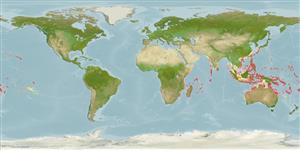Classification / Names
Common names from other countries
Main reference
Size / Weight / Age
Max length : 27.5 cm TL male/unsexed; (Ref. 48600)
Length at first maturity
Lm 19.0 range ? - ? cm
Environment
Marine; reef-associated; depth range 0 - 30 m (Ref. 4319), usually 6 - ? m (Ref. 37816)
Climate / Range
Tropical, preferred ?; 33°N - 31°S, 30°E - 130°W (Ref. 5222)
Distribution
Indo-West Pacific: none have been taken on the African coast, except for the specimen recorded by Randall and Heemstra 1991(Ref. 4787) from Kenyan coast north of Kilifi Creek. It is an insular species found in most tropical Indo-Pacific islands. Absent in the Red Sea and Persian Gulf.
Countries | FAO areas | Ecosystems | Occurrences | Introductions
Short description
Dorsal
spines
(total): 11;
Dorsal
soft rays
(total): 15-17;
Anal
spines: 3;
Anal
soft rays: 8. Small but conspicuous triangular white spots on the corners of the brown hexagons of the vertical fins and all of the body except the belly; four to six dark blotches along the dorsal fin base (Ref. 37816); further characterized by having ctenoid scales on body except cycloid anterodorsally above lateral line, on thorax and abdomen; body with auxiliary scales; greatest depth of body 2.8-3.5 in SL; rounded caudal fin; pelvic fins 1.8-2.1 in head length (Ref. 90102); HL 2.5-2.6 times in SL; flat interorbital area, convex dorsal head profile; rounded preopercle, slightly enlarged ventral serrae; upper edge of operculum convex; posterior and anterior nostrils subequal; maxilla reaches to or past vertical at rear edge of eye; smoothly curved ventral edge of maxilla; 3-5 rows of teeth on midlateral part of lower jaw (Ref. 89707).
IUCN Red List Status (Ref. 115185)
Threat to humans
Harmless
Human uses
Fisheries: minor commercial; gamefish: yes
More information
ReferencesAquacultureAquaculture profileStrainsGeneticsAllele frequenciesHeritabilityDiseasesProcessingMass conversion
Tools
Special reports
Download XML
Internet sources
Estimates of some properties based on models
Phylogenetic diversity index
PD50 = 0.5000 many relatives (e.g. carps) 0.5 - 2.0 few relatives (e.g. lungfishes)
Trophic Level
4.1 ±0.67 se; Based on food items.
Resilience
High, minimum population doubling time less than 15 months (K=0.9)
Vulnerability
Low vulnerability (17 of 100)
Price category
